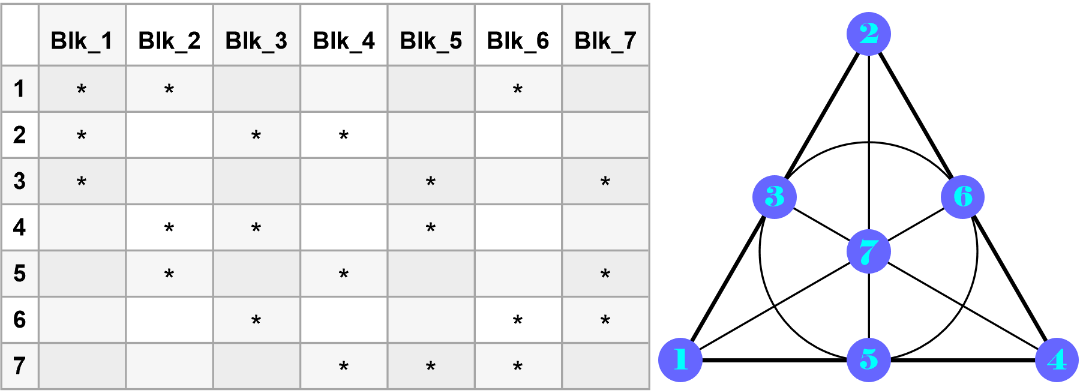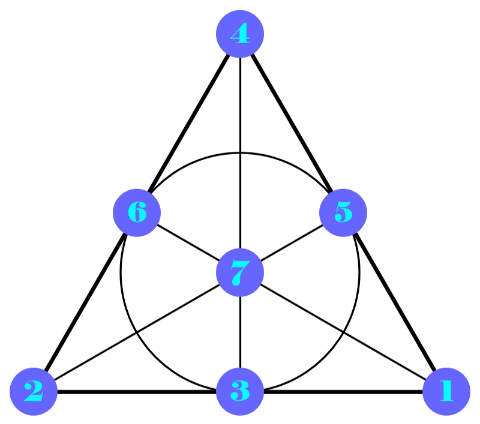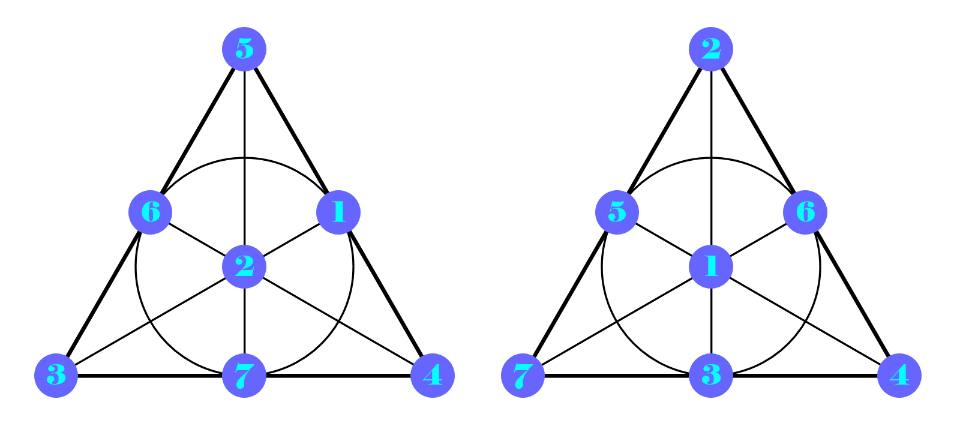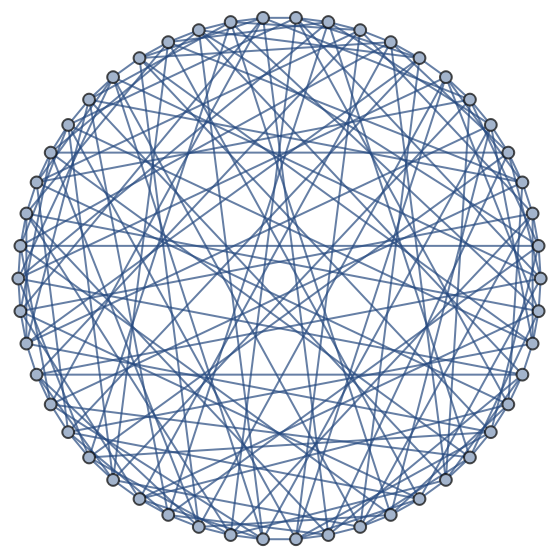Basic Examples (3)
Given the configuration {2,3,1,5,4,6,7}, show its Fano plane diagram:
Given the configuration {2,3,1,5,4,6,7}, find all isomorphic permutations that preserves collineation:
Verify the number of isomorphism generated is 168:
Given the configuration {2,3,1,5,4,6,7}, show the Fano plane block table for it and one of its isomorphisms:
Scope (1)
In the following, block 1 corresponds to the line through triplet {1,2,3} regardless of order. One can find the same triplet on the left side on the diagram. Block 7 has three dots for 3, 5 and 6 which corresponds to the circle (general line) in the Fano diagram and analogously for the other columns:
Properties and Relations (2)
The visual proof below shows the existence of an isomorphic permutation of a given configuration in a trivial way. For instance {2,3,1,5,4,6,7} has the following Fano plane:
Rotation of the above diagram 120 degrees counterclockwise about 7 will preserve the collinearity of all points:
Show the corresponding Fano plane:
The cycle structure for permutations of the isomorphic family has 6 conjugacy classes. Use FindFanoPlaneIsomorphism to verify the enumeration given on Wikipedia:
One of the permutations is the identity permutation:
21 of the permutations have two 2-cycles:
Similarly, 42 of the permutations have one 2-cycle and one 4-cycle:
56 of the permutations have two 3-cycles:
48 of the permutations have a 7-cycle:
The 48 permutations are composed of two conjugacy classes:
1) A maps to B, B to C, C to D. Then D is on the same line as A and B.
2) A maps to B, B to C, C to D. Then D is on the same line as A and C.
Both classes can be found directly using the reference diagram in Details & Options:
Each class has 24 items:
Possible Issues (2)
The input must be a permutation of {1,2,3,4,5,6,7}. Otherwise the function returns unevaluated with an error message:
The property must be one of "BlockTable", "Diagram" or "All". Otherwise, the function returns all isomorphisms only:
Neat Examples (2)
Compare two isomorphic Fano planes for a given configuration with both diagram and block table:
The collinearities are identical for both diagrams. For instance, one can find a general line through the triplet {5,6,3} in both diagrams:
The two associated block tables are identical up to column swapping: {1→7,2→2,3→5,4→1,5→3,6→4,7→6}, where 1→7 compares the first column in the left table to the seventh column in the right table and so on:
Build the Hoffman-Singleton graph. First we generate all even permutation of the given configuration:
There are exactly 15 non-isomorphic Fano planes:
Find 7 collinear triplets in each configuration. Generate blocks or collinear points on the reference Fano plane:
Show the collinear blocks for the first of the 15 Fano planes:
Show the Fano plane diagram for this configuration:
The Hoffman-Singleton graph has two types of connections:
1. the Fano plane to its 7 collinear triplets
2. a triplet to another disjoint triplet
In total there should be 50 = 15 + 35 nodes and 175 edges:
Set up customized styles for vertices and edges:
Mark the Fano planes with triangles and the collinear triplets with circles in the graph:
The arrangement of nodes follows a pre-computed Hamiltonian cycle of this graph. The above diagram is isomorphic to the built-in entity:


![config = {2, 3, 1, 5, 4, 6, 7};
isoBTAsso = ResourceFunction["FindFanoPlaneIsomorphism"][config, "BlockTable"];
GraphicsRow[{isoBTAsso[config], isoBTAsso[[2]]}]](https://www.wolframcloud.com/obj/resourcesystem/images/3d0/3d0327af-702d-4cc6-b8e8-8c6f1bb42b5c/2b1559b9da68b269.png)

![config = {2, 3, 1, 5, 4, 6, 7};
{isoBTAsso, isoDiagAsso} = ResourceFunction["FindFanoPlaneIsomorphism"][config, "All"];
{isoBTAsso[config], isoDiagAsso[config]} // Row](https://www.wolframcloud.com/obj/resourcesystem/images/3d0/3d0327af-702d-4cc6-b8e8-8c6f1bb42b5c/3e08c9439ad5b942.png)

![config = {2, 3, 1, 5, 4, 6, 7};
isoDiagAsso = ResourceFunction["FindFanoPlaneIsomorphism"][config, "Diagram"];
isoDiagAsso[config]](https://www.wolframcloud.com/obj/resourcesystem/images/3d0/3d0327af-702d-4cc6-b8e8-8c6f1bb42b5c/62226bb906ebda53.png)


![config = \!\(TraditionalForm\`{2, 3, 1, 5, 4, 6, 7}\);
iso = ResourceFunction["FindFanoPlaneIsomorphism"][config];
cycles = FindPermutation[config, #] & /@ iso;
cycles // Short](https://www.wolframcloud.com/obj/resourcesystem/images/3d0/3d0327af-702d-4cc6-b8e8-8c6f1bb42b5c/52a209783f42069f.png)
![case1 = Cases[
sevenCyc, _?(Function[{item}, MemberQ[refFanoPlane, _?(SubsetQ[#, item[[1, 1, {1, 2, 4}]]] &)]])];](https://www.wolframcloud.com/obj/resourcesystem/images/3d0/3d0327af-702d-4cc6-b8e8-8c6f1bb42b5c/42ea1470b0fafe38.png)
![case2 = Cases[
sevenCyc, _?(Function[{item}, MemberQ[refFanoPlane, _?(SubsetQ[#, item[[1, 1, {1, 3, 4}]]] &)]])];](https://www.wolframcloud.com/obj/resourcesystem/images/3d0/3d0327af-702d-4cc6-b8e8-8c6f1bb42b5c/7ad3d0e79c4d2dd2.png)
![config = {2, 3, 1, 5, 4, 6, 7};
SeedRandom[314159];
{blkTable, diagram} = ResourceFunction["FindFanoPlaneIsomorphism"][config, "All"];
isoPair = RandomChoice[blkTable // Keys, 2]](https://www.wolframcloud.com/obj/resourcesystem/images/3d0/3d0327af-702d-4cc6-b8e8-8c6f1bb42b5c/654c2eec54b4d1ab.png)


![fpForHSG = {};
SeedRandom["FanoPlane"];
NestWhileList[Module[{temp},
temp = RandomChoice[#];
AppendTo[fpForHSG, temp];
Complement[#, ResourceFunction["FindFanoPlaneIsomorphism"][temp]]
] &, evenPerm, Length[#] > 1 &];](https://www.wolframcloud.com/obj/resourcesystem/images/3d0/3d0327af-702d-4cc6-b8e8-8c6f1bb42b5c/37e5dbbb38b2b4c3.png)
![With[{config = {1, 6, 5, 2, 3, 7, 4}},
ResourceFunction["FindFanoPlaneIsomorphism"][config, "Diagram"][
config]]](https://www.wolframcloud.com/obj/resourcesystem/images/3d0/3d0327af-702d-4cc6-b8e8-8c6f1bb42b5c/5acb2a1450841f85.png)

![(*Red*)
type2 = With[{blocks = Flatten[fanoBlocks /@ fpForHSG, 1] // Union}, Table[If[DisjointQ[blocks[[e1]], blocks[[e2]]], blocks[[e1]] \[UndirectedEdge] blocks[[e2]], Nothing],
{e1, 35}, {e2, e1, 35}] // Flatten];](https://www.wolframcloud.com/obj/resourcesystem/images/3d0/3d0327af-702d-4cc6-b8e8-8c6f1bb42b5c/5156c81486cd5479.png)
![circleLayout[n_] := Table[{Cos[2 \[Pi]/n i], Sin[2 \[Pi]/n i]}, {i, n}] // N;
ef1[el_, el2_] := If[Length[el[[1]]] == 7 || Length[el2[[2]]] == 7, {Lighter[Blue, 0.3], Line[el]}, {Red, Line[el]}]](https://www.wolframcloud.com/obj/resourcesystem/images/3d0/3d0327af-702d-4cc6-b8e8-8c6f1bb42b5c/023014d80838686b.png)
![g = Graph[type2~Join~type1,
VertexCoordinates ->
Thread[{{1, 2, 3}, {6, 1, 5, 2, 7, 3, 4}, {2, 5, 7}, {1, 4, 6}, {2,
3, 7}, {1, 4, 5}, {2, 3, 6}, {1, 4, 7}, {2, 5, 6}, {1, 3, 7}, {
2, 4, 5}, {1, 3, 6}, {2, 4, 7}, {4, 2, 7, 1, 3, 5, 6}, {1, 2, 5}, {4, 6, 5, 2, 1, 7, 3}, {3, 5, 7}, {2, 3, 1, 4, 5, 6, 7}, {3,
4, 6}, {5, 7, 6, 1, 2, 4, 3}, {5, 6, 7}, {4, 6, 2, 7, 1, 5, 3}, {3, 4, 7}, {1, 5, 6}, {1, 6, 5, 2, 3, 7, 4}, {2, 3, 5}, {1, 6, 7}, {2, 3, 4}, {1, 5, 7}, {2, 4, 6}, {1, 3, 5}, {2, 6, 7}, {
1, 3, 4}, {3, 2, 6, 1, 5, 7, 4}, {1, 2, 7}, {3, 4, 5}, {1, 2, 6}, {2, 4, 3, 5, 6, 1, 7}, {4, 6, 7}, {5, 3, 4, 6, 7, 1, 2}, {1,
2, 4}, {7, 5, 2, 6, 3, 4, 1}, {4, 5, 6}, {7, 2, 4, 3, 1, 5, 6}, {3, 6, 7}, {2, 3, 4, 7, 5, 6, 1}, {4, 5, 7}, {4, 6, 2, 5, 1,
3, 7}, {3, 5, 6}, {2, 1, 3, 6, 5, 4, 7}} -> circleLayout[50]],
EdgeShapeFunction -> ef1,
VertexShapeFunction -> {ele_ /; (Length[ele] == 7) -> "Triangle"}]](https://www.wolframcloud.com/obj/resourcesystem/images/3d0/3d0327af-702d-4cc6-b8e8-8c6f1bb42b5c/7d66b66859c0bc51.png)

